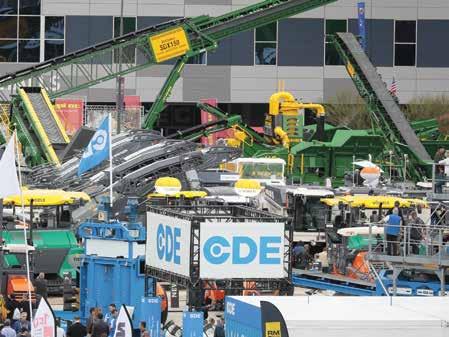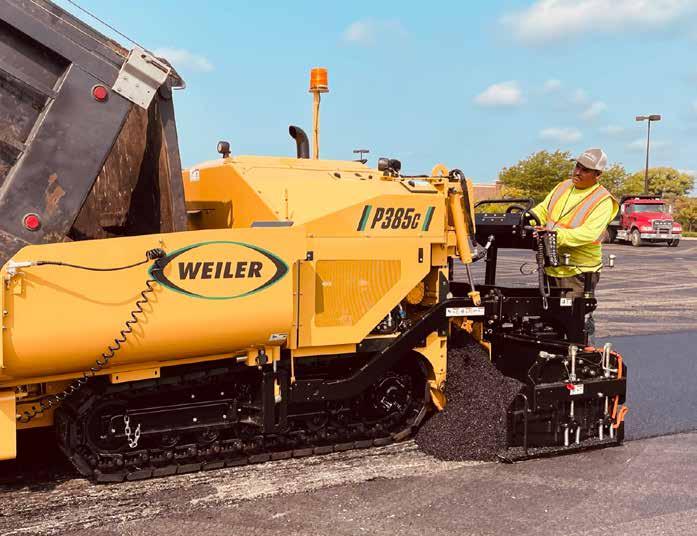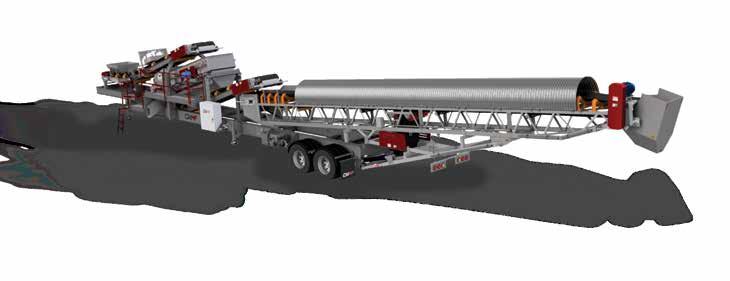
6 minute read
Here’s What to do When Half the Trucks Cancel
BY SANDY LENDER
Your asphalt paving crew has on site all the necessary equipment to pave the final 1.5-inch (compacted) lift of a section of residential subdivision roadway. The superintendent has requested 300 tons of mix from the plant, which is 45 minutes from the job. This amount of mix will be sufficient for the day and will give the crew enough time to complete the job for the pavement marking subcontractor scheduled later in the day, and to load up to move to tomorrow’s project. The six haul trucks the super has ordered for the day each hold 20 tons.
Keep in mind, a 45-minute drive from the plant follows an indeterminate load-out time in the yard. Dumping time at the paver depends upon paving speed, size of the hopper or insert, and whether the crew is building a starter pad or flare during that round—remember that performing handwork of any nature tends to slow the operation and might leave a truck sitting on the sidelines while it waits its turn to charge the hopper. Cleanout time after dumping should be quick and not add many minutes to the truck’s round-trip time, but traffic’s impact will fluctuate depending on the time of day and the route the driver selects—for example, does he know to avoid the local elementary school drop-off and bus traffic?
Here’s where our project management dilemma comes in.
When all crewmembers arrive at the jobsite and have the morning toolbox talk, the foreman receives a text message from dispatch saying three of the six trucks have cancelled.
We all know you can’t start and stop the paver waiting on trucks throughout the day without the risk of dips and bumps in the mat. We also know there are variables such as catch basins, utility covers, flares, stubs, intersections and so on to have as time-eaters in the back of your mind, so what’s the savvy foreman to do? A handful of industry consultants weighed in to share ideas for handling this mini crisis without compromising quality.
This component makes it possible for you to never have to second - guess how much material is in your A.C. tanks or hotmix silos. The Accu-Level continuously monitors tank levels aler ting the operator when an overfill is approaching.
The app allows you to monitor specific operations of your plant. While using it, you can: observe tank and silo levels in real-time, keep track of temperatures, monitor hot oil heater vitals, receive error alerts, allow team access, and more. Completely mobile-friendly, the app can be operated on a computer, tablet or any smart phone.
This system allows you to monitor and regulate all of your A.C. tanks. Users can set individual tank high/low parameters for level and temperature to initiate a pump shutdown and prevent tank overflows. In addition, you can operate A.C. tank supply, return, and fill valves with the push of a button from the control room, tank farm or any smart phone.
He shared: “For this situation, the mix temperature and cooling come into consideration. Tarping loads and using an MTV would be beneficial to keep the mix as hot as possible. Maybe also communicating with the plant to maximize mix temperatures. Depending on the temperature outside and the equipment being used, the first loads may be able to fill the MTV and sit for a moment for the trucks to start on their approximately 90-minute round trip back to the plant. With only 60 tons at a time and 1.5-inch compacted thickness, they would be paving about 500 feet for each round of three trucks. For a 90-minute pace, that is paving about 5 feet per minute. The crew is limited by how fast they can receive material. Even if they pave slower, the overall time onsite will be the same.”
Schaefer pointed out a great way for the paving crew to maximize the spacing of waiting on trucks.
“Ideally, since this is a residential street there would be stopping points for intersections or handwork areas. If the crew could pave up to these areas and wait for trucks, it would improve smoothness. If this was a highway pavement, hopefully they would have trucks on standby for this situation.”
Bryce Wuori of Wuori Consulting, Bismarck, North Dakota, shared: “As the paving super in this situation the first thing I would do is try to find more trucks to complete the paving as scheduled. Slowing the paver down to accommodate the material being delivered to the project is a good way to control quality as long as the weather conditions are in favor. Obviously, on top lift we want to eliminate joints and surface defections and build a high-quality road so trying to keep the project on schedule with the addition of trucks would be my first suggestion. Then if that fails, we slow the paver down and keep things moving at a pace that still allows quality and does not disrupt the schedule of the project more than we can already control.”
Wuori stressed the importance of pleasing the client here.
“Since this is in a residential neighborhood one of the biggest things I would try to do as the paving super is build a high-quality road that is aesthetically pleasing to the taxpayers/homeowners while using the equipment and trucks we have. It might end up being a longer day of paving to get the job done but this kind of thing happens almost every day in the field.”
PAVING CONSULTANTS YOU CAN COUNT ON
In alphabetical order by last name, here are the three consultants who offered commentary for the scenario in this article.
John Ball III
Top Quality Paving & Training
(603) 493-1458 tqpaving@yahoo.com • https://tqpaving.com
Nicholas Schaefer, PE
Surface Systems and Instruments Inc.
(415) 595-5302 nschaefer@smoothroad.com • smoothroad.com
Bryce Wuori
Wuori Consulting LLC
(701) 426-7873
Bryce.w.wuori@gmail.com
John Ball, the proprietor of Top Quality Paving & Training, based in Manchester, New Hampshire, has been on the job when the news came down that haul trucks weren’t showing up for the day. To stay on task, they solved the problem by looking for replacement trucks. “One option is to look for other trucks,” Ball said. “You need to ask how important is this job compared to another coming out of the plant because you might be able to scavenge three trucks from that other job to make this project happen today.”
He shared that a larger company will have more wiggle room than a smaller one. “At Pike, we had 24 paving crews. Whenever we had a situation where a couple trucks didn’t show up, I could call over to another super and say, ‘Hey, Jody, can you spare me three trucks for the day?’ A company with only one crew out paving might be tempted to call on someone they know who drives a truck. If you’re going to hire an independent driver, make sure they have all the insurance and properly maintained trucks for hauling asphalt.”
Once again, pre-planning comes into play. You’ll want to revamp the original plan at this point. If you can’t get all the trucks you need for the job, Ball said you have to plan where you’ll stop at the end of the workshift. “I’m not going to finish the job with half the trucks, unless I go more hours. Then you have to factor in overtime and might have to set up lighting. It depends on how crucial the job is, but if you can cancel and do the whole job all at once another day, that’s the best thing to do. I’d rather do it all at once than do part today, stopping near the end of the workshift with 200 tons delivered, and find out we can’t get back to finish tomorrow or the next day.”
Guessing the multitude of variables for this situation isn’t easy.
Not all residential paving contractors will have deployed an MTV with the paving crew, but they should all have a skid steer on the job. Employing a skid steer to move material for handwork, tight spaces, starter pad builds, flares and the like, the crew can trim some minutes off the time a haul truck driver spends waiting his turn to charge the hopper.
Not all haul truck drivers will be excited to double the number of trips they were scheduled or expected to perform for a day. Not all workers will be able to extend their workday beyond their scheduled shift. But if the paving foreman can show his flexibility and good attitude by working up a solution for his crew, they can still get a quality pavement for the client. There are ways to optimize the crew’s efficiency even if they must work with fewer trucks or if the paving speed is slowed, but keep in mind, the roller operator(s) must match the paving speed. He’s not bringing the breakdown roller onto the mat until the first pass is ready. If you’re moving too slowly, you could see cut marks and quality shortcuts in the rolling pattern. Keep an eye on this stage of the operation, too.
Web Extra
You probably dealt with a similar situation in 2022 and have good ideas for handling it. We welcome you to share your ideas with one another. This issue mails Jan. 20, and we’ll post this article to our facebook page for discussion Jan. 30. Check the AsphaltPro Magazine facebook page on that date!







